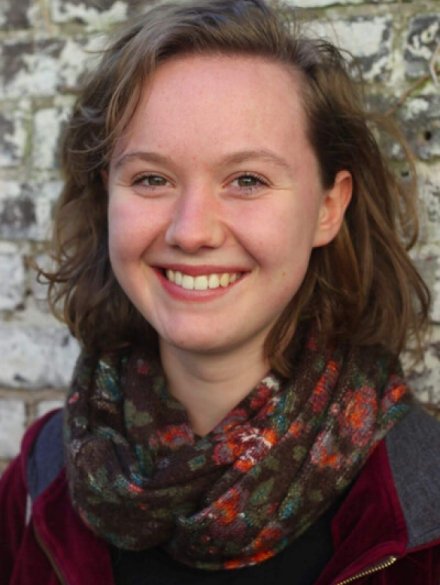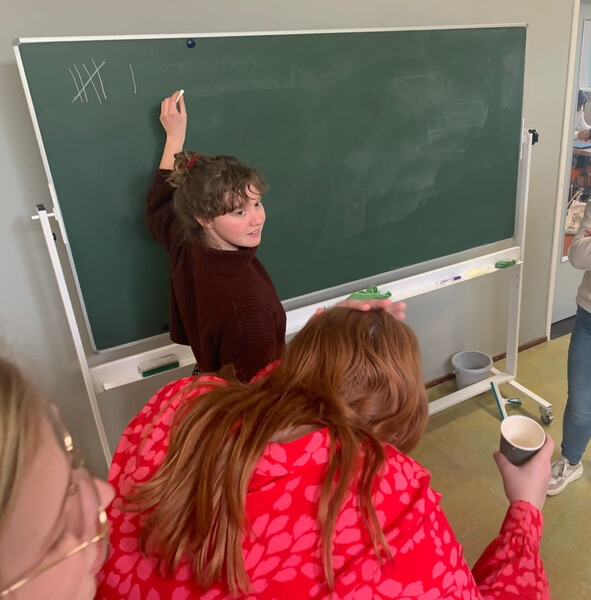Sarah Louike van Leer

Positioning
My name is Sarah Louike van Leer and my work is focused around the development of creative educational programs/tools/resources for (young) people who want to position themselves in society in a critical, self-reflective and innovative way. As an artist-educator, I connect my knowledge of cultural anthropology, theatre in education and critical thinking to create, and work with new educational methods. More specifically, I focus on educating the educator since they will raise our next generation (in the educational sense). For me, the difference between the teacher and the educator is important since the role of the educator is much more about facilitating learning instead of imposing knowledge on students, unlike that of the teacher. To me, the educator is someone who is in dialogue with their students and who works in a rhizomatic way. In my opinion, the importance of educators in our society is highly underrated. We need educators with a new perspective and a modern method to stimulate our new generation to fulfill their full potential in our fast-changing contemporary society. The connecting and innovative strengths of the arts in relation to education is one of the main motivators for my work and I would like to continue to develop this passion throughout my career. In other words, to be an artist-educator in my view, is to be a creative and open-minded educator who works in innovative and surprising ways on every job he/she/they takes on.

Where theory meets artist-education
My methodology and view on education have been strongly inspired by Paulo Freire, Gert Biesta, and Ken Robinson. In Freire’s work, he writes about the conservative education-system in which the main methodology is the banking education system. This system works by ‘depositing facts into the minds of passive students’ (Freire institute 2022). I agree with Robinson, Biesta and Freire that this type of education is educating students in a way in which they cannot develop into autonomous and aware citizens of the world. I identify with the methodologies of Robinson and Biesta in which they write about the importance of stimulating young people “to engage with the world within them as well as the world around them”. (Robinson 2015, p. 48) Biesta calls this engagement of young people with the world “the dialogue between student and the world”. (Biesta 2014, p. 43). This ever-present dialogue is at the core of what I find important in my work.
We live in a time in which the need for innovative and creative thinkers has never been bigger (Robinson 2015, p. 50). Banking education does not stimulate young minds to develop in an autonomous or creative way. Therefore, as an artist-educator I believe just as Freire, in the importance of giving the students agency in their study program. Being inspired by the methodologies of Freire, Biesta and Robinson, brings me to the conclusion that education should give people the tools to become capable to think critically, with empathy and creatively, so we can continue to exist and develop in this ever-changing society. As Biesta says: “Let us take the beautiful risk that is inherent in the art of education.” (Biesta 2014)

Being an artist-educator is, however, not only about the art of education itself. Since the view on education that is described in the above implies a great importance of creativity and arts as a part of learning, an artist-educator must also develop and bring forth their own artistic practice. When educational theory meets my inspiration in artistic and conflict theories, Lederach and Boal come to play. Lederach wrote about the importance of imagination for creating the space that people need to stimulate peace and relationships. (Lederach 2005, Pp. 3-4) Or in his words:
The north of peacebuilding is best articulated as finding our way toward becoming and being local and global human communities characterized by respect, dignity, fairness, cooperation, and the nonviolent resolution of conflict. To understand this north, to read such a compass, requires that we recognize and develop our moral imagination far more intentionally.
Boal writes about the power of theatre to help people reflect on situations of oppression in their lives (Boal 1985): “Theatre is the most perfect artistic form of coercion.”
My practice exists around storytelling, in any possible form but with the focus on applied theatre in which I combine the importance of imagination, reflection and critical thought. In this practice, I try to combine the methodologies of Lederach and Boal in which the arts are a means for creative education and/or social change.
Work method
Before creating or designing creative education, I find it very important to get to know the context of the people for whom the education is supposed to be. In other words, I would never enter a new area/school/university with a rigid education plan. I would do the opposite: depending on the means and time available, I would conduct an introductory project by the means of Arts based Research (Sullivan 2010) and ethnographic research (Kirner & Mills 2019) or, if there is less time, do a smaller context research online. Then, when the issues or main themes of the community/organization/group are brought up, I create and provide workshops and lesson series in which I can work as a performer, facilitator, trainer and/or educator. In every session of whatever project I do, I determine multiple learning outcomes with others educators and/or the students that will participate. These goals should be made transparent to the students of the project. However, I will never decide how exactly these learning outcomes should be achieved. Also, these goals should always be fluid and multi-interpretable. In the project I will provide tools, assignments, exercises and so on in which students have the space to activate their imagination, reflection and critical thought. There has to be space for students to take agency, to question me or to question the project. Of course, every project will be done with a great sense of cultural sensitivity.
s
Concluding, exchange=change
In conclusion, as an artist-educator that works through storytelling, the type of work I provide does not simply consist of a lesson plan that can be standardized. It is specific for the group that it is designed for and is fluid, open for change. Whatever we will do in a group, depends on what the students bring with them on any given day. There will be space for exchange because I do not see myself as a teacher but as an educator, in which the role of facilitation is much bigger, as I mentioned in the first paragraph. If students have knowledge to convey to me or other students, there must be space for that as well. In that exchange, knowledge can transform perspective, can be combined and can be translated into new contexts. This exchange will be the base of the grassroot change in which we as educators stimulate a new generation of developing educators who work creatively and stimulate young people to position themselves critically in society.
Deze pagina is voor het laatst gewijzigd op 25 augustus 2022
Sta jij op deze pagina? En heb je een opmerking? Mail naar de redactie.